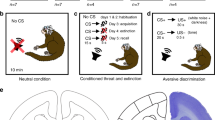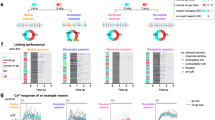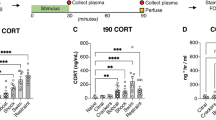Abstract
Personal success often requires the choice to expend greater effort for larger rewards, and deficits in such effortful decision making accompany a number of illnesses including depression, schizophrenia, and attention-deficit/hyperactivity disorder. Animal models have implicated brain regions such as the basolateral amygdala (BLA) and anterior cingulate cortex (ACC) in physical effort-based choice, but disentangling the unique contributions of these two regions has proven difficult, and effort demands in industrialized society are predominantly cognitive in nature. Here we utilize the rodent cognitive effort task (rCET), a modification of the five-choice serial reaction-time task, wherein animals can choose to expend greater visuospatial attention to obtain larger sucrose rewards. Temporary inactivation (via baclofen–muscimol) of BLA and ACC showed dissociable effects: BLA inactivation caused hard-working rats to ‘slack off’ and ‘slacker’ rats to work harder, whereas ACC inactivation caused all animals to reduce willingness to expend mental effort. Furthermore, BLA inactivation increased the time needed to make choices, whereas ACC inactivation increased motor impulsivity. These data illuminate unique contributions of BLA and ACC to effort-based decision making, and imply overlapping yet distinct circuitry for cognitive vs physical effort. Our understanding of effortful decision making may therefore require expanding our models beyond purely physical costs.
Similar content being viewed by others
Log in or create a free account to read this content
Gain free access to this article, as well as selected content from this journal and more on nature.com
or
References
Ambroggi F, Ishikawa A, Fields HL, Nicola SM (2008). Basolateral amygdala neurons facilitate reward-seeking behavior by exciting nucleus accumbens neurons. Neuron 59: 648–661.
Basten U, Biele G, Heekeren HR, Fiebach CJ (2010). How the brain integrates costs and benefits during decision making. Proc Natl Acad Sci USA 107: 21767–21772.
Bechara A, Damasio H, Damasio AR, Lee GP (1999). Different contributions of the human amygdala and ventromedial prefrontal cortex to decision-making. J Neurosci 19: 5473–5481.
Belova MA, Paton JJ, Morrison SE, Salzman CD (2007). Expectation modulates neural responses to pleasant and aversive stimuli in primate amygdala. Neuron 55: 970–984.
Belova MA, Paton JJ, Salzman CD (2008). Moment-to-moment tracking of state value in the amygdala. J Neurosci 28: 10023–10030.
Boorman ED, Rushworth MF, Behrens TE (2013). Ventromedial prefrontal and anterior cingulate cortex adopt choice and default reference frames during sequential multi-alternative choice. J Neurosci 33: 2242–2253.
Brand M, Grabenhorst F, Starcke K, Vandekerckhove MM, Markowitsch HJ (2007). Role of the amygdala in decisions under ambiguity and decisions under risk: evidence from patients with Urbach-Wiethe disease. Neuropsychologia 45: 1305–1317.
Cai X, Padoa-Schioppa C (2012). Neuronal encoding of subjective value in dorsal and ventral anterior cingulate cortex. J Neurosci 32: 3791–3808.
Cocker PJ, Hosking JG, Benoit J, Winstanley CA (2012). Sensitivity to cognitive effort mediates psychostimulant effects on a novel rodent cost/benefit decision-making task. Neuropsychopharmacology 37: 1825–1837.
Croxson PL, Walton ME, O'Reilly JX, Behrens TE, Rushworth MF (2009). Effort-based cost-benefit valuation and the human brain. J Neurosci 29: 4531–4541.
Dolan RJ (2012) Neuroscience of Preference and Choice: Cognitive and Neural Mechanisms 1st edn. Academic Press/Elsevier: London; Waltham, MA. xiv, 342p.
Egeland J, Johansen SN, Ueland T (2010). Do low-effort learning strategies mediate impaired memory in ADHD? J Learn Disabil 43: 430–440.
Endepols H, Sommer S, Backes H, Wiedermann D, Graf R, Hauber W (2010). Effort-based decision making in the rat: an [18F]fluorodeoxyglucose micro positron emission tomography study. J Neurosci 30: 9708–9714.
Everitt BJ, Cardinal RN, Parkinson JA, Robbins TW (2003). Appetitive behavior: impact of amygdala-dependent mechanisms of emotional learning. Ann N Y Acad Sci 985: 233–250.
Floresco SB, Ghods-Sharifi S (2007). Amygdala-prefrontal cortical circuitry regulates effort-based decision making. Cerebral Cortex 17: 251–260.
Floresco SB, Ghods-Sharifi S, Vexelman C, Magyar O (2006). Dissociable roles for the nucleus accumbens core and shell in regulating set shifting. J Neurosci 26: 2449–2457.
Floresco SB, St Onge JR, Ghods-Sharifi S, Winstanley CA (2008a). Cortico-limbic-striatal circuits subserving different forms of cost-benefit decision making. Cogn Affect Behav Neurosci 8: 375–389.
Floresco SB, Tse MT, Ghods-Sharifi S (2008b). Dopaminergic and glutamatergic regulation of effort- and delay-based decision making. Neuropsychopharmacology 33: 1966–1979.
Ghods-Sharifi S, St Onge JR, Floresco SB (2009). Fundamental contribution by the basolateral amygdala to different forms of decision making. J Neurosci 29: 5251–5259.
Gold JM, Strauss GP, Waltz JA, Robinson BM, Brown JK, Frank MJ (2013). Negative symptoms of schizophrenia are associated with abnormal effort-cost computations. Biol Psychiatry 74: 130–136.
Hammar A, Strand M, Ardal G, Schmid M, Lund A, Elliott R (2011). Testing the cognitive effort hypothesis of cognitive impairment in major depression. Nord J Psychiatry 65: 74–80.
Herrnstein RJ (1970). On the law of effect. J Exp Anal Behav 13: 243–266.
Ishikawa A, Ambroggi F, Nicola SM, Fields HL (2008). Contributions of the amygdala and medial prefrontal cortex to incentive cue responding. Neuroscience 155: 573–584.
Izuma K, Matsumoto M, Murayama K, Samejima K, Sadato N, Matsumoto K (2010). Neural correlates of cognitive dissonance and choice-induced preference change. Proc Natl Acad Sci USA 107: 22014–22019.
Janes AC, Jensen JE, Farmer SL, Frederick BD, Pizzagalli DA, Lukas SE (2013). GABA levels in the dorsal anterior cingulate cortex associated with difficulty ignoring smoking-related cues in tobacco-dependent volunteers. Neuropsychopharmacology 38: 1113–1120.
Jenison RL, Rangel A, Oya H, Kawasaki H, Howard MA (2011). Value encoding in single neurons in the human amygdala during decision making. J Neurosci 31: 331–338.
Kool W, McGuire JT, Rosen ZB, Botvinick MM (2010). Decision making and the avoidance of cognitive demand. J Exp Psychol Gen 139: 665–682.
Le Berre AP, Rauchs G, La Joie R, Mezenge F, Boudehent C, Vabret F et al (2012). Impaired decision-making and brain shrinkage in alcoholism. Eur Psychiatry S0924-9338: 00136–00138.
Luk CH, Wallis JD (2013). Choice coding in frontal cortex during stimulus-guided or action-guided decision-making. J Neurosci 33: 1864–1871.
Manes F, Sahakian B, Clark L, Rogers R, Antoun N, Aitken M et al (2002). Decision-making processes following damage to the prefrontal cortex. Brain 125 (Pt 3): 624–639.
Marquis JP, Killcross S, Haddon JE (2007). Inactivation of the prelimbic, but not infralimbic, prefrontal cortex impairs the contextual control of response conflict in rats. Eur J Neurosci 25: 559–566.
McGuire JT, Botvinick MM (2010). Prefrontal cortex, cognitive control, and the registration of decision costs. Proc Natl Acad Sci USA 107: 7922–7926.
Morrison SE, Salzman CD (2010). Re-valuing the amygdala. Curr Opin Neurobiol 20: 221–230.
Muir JL, Everitt BJ, Robbins TW (1996). The cerebral cortex of the rat and visual attentional function: dissociable effects of mediofrontal, cingulate, anterior dorsolateral, and parietal cortex lesions on a five-choice serial reaction time task. Cereb Cortex 6: 470–481.
Naccache L, Dehaene S, Cohen L, Habert MO, Guichart-Gomez E, Galanaud D et al (2005). Effortless control: executive attention and conscious feeling of mental effort are dissociable. Neuropsychologia 43: 1318–1328.
Paxinos G, Watson C (1998) The Rat Brain in Stereotaxic Coordinates 4th edn. Academic Press: San Diego. xxvi, [237] p of platespp.
Randall PA, Pardo M, Nunes EJ, Lopez Cruz L, Vemuri VK, Makriyannis A et al (2012). Dopaminergic modulation of effort-related choice behavior as assessed by a progressive ratio chow feeding choice task: pharmacological studies and the role of individual differences. PLoS ONE 7: e47934.
Robbins TW (2002). The 5-choice serial reaction time task: behavioural pharmacology and functional neurochemistry. Psychopharmacology (Berl) 163: 362–380.
Rudebeck PH, Walton ME, Smyth AN, Bannerman DM, Rushworth MF (2006a). Separate neural pathways process different decision costs. Nat Neurosci 9: 1161–1168.
Rudebeck PH, Walton ME, Smyth AN, Bannerman DM, Rushworth MFS (2006b). Separate neural pathways process different decision costs. Nat Neurosci 9: 1161–1168.
Salamone JD (2009). Dopamine, effort, and decision making: theoretical comment on Bardgett et al (2009). Behav Neurosci 123: 463–467.
Salamone JD, Correa M, Farrar A, Mingote SM (2007). Effort-related functions of nucleus accumbens dopamine and associated forebrain circuits. Psychopharmacology (Berl) 191: 461–482.
Salamone JD, Cousins MS, Bucher S (1994). Anhedonia or anergia? Effects of haloperidol and nucleus accumbens dopamine depletion on instrumental response selection in a T-maze cost/benefit procedure. Behav Brain Res 65: 221–229.
Schmidt L, Lebreton M, Clery-Melin ML, Daunizeau J, Pessiglione M (2012). Neural mechanisms underlying motivation of mental versus physical effort. PLoS Biol 10: e1001266.
Schweimer J, Hauber W (2006). Dopamine D1 receptors in the anterior cingulate cortex regulate effort-based decision making. Learn Mem 13: 777–782.
Schweimer J, Saft S, Hauber W (2005). Involvement of catecholamine neurotransmission in the rat anterior cingulate in effort-related decision making. Behav Neurosci 119: 1687–1692.
Smith BW, Mitchell DG, Hardin MG, Jazbec S, Fridberg D, Blair RJ et al (2009). Neural substrates of reward magnitude, probability, and risk during a wheel of fortune decision-making task. Neuroimage 44: 600–609.
Sokol-Hessner P, Camerer CF, Phelps EA (2013). Emotion regulation reduces loss aversion and decreases amygdala responses to losses. Social Cognitive Affective Neurosci 8: 341–350.
Treadway MT, Bossaller NA, Shelton RC, Zald DH (2012a). Effort-based decision-making in major depressive disorder: a translational model of motivational anhedonia. J Abnorm Psychol 121: 553–558.
Treadway MT, Buckholtz JW, Cowan RL, Woodward ND, Li R, Ansari MS et al (2012b). Dopaminergic mechanisms of individual differences in human effort-based decision-making. J Neurosci 32: 6170–6176.
van Honk J, Eisenegger C, Terburg D, Stein DJ, Morgan B (2013). Generous economic investments after basolateral amygdala damage. Proc Natl Acad Sci USA 110: 2506–2510.
Walton ME, Bannerman DM, Alterescu K, Rushworth MF (2003a). Functional specialization within medial frontal cortex of the anterior cingulate for evaluating effort-related decisions. J Neurosci 23: 6475–6479.
Walton ME, Bannerman DM, Alterescu K, Rushworth MFS (2003b). Functional specialization within medial frontal cortex of the anterior cingulate for evaluating effort-related decisions. J Neurosci 23: 6475–6479.
Walton ME, Bannerman DM, Rushworth MFS (2002). The role of rat medial frontal cortex in effort-based decision making. J Neurosci 22: 10996–11003.
Walton ME, Devlin JT, Rushworth MF (2004). Interactions between decision making and performance monitoring within prefrontal cortex. Nat Neurosci 7: 1259–1265.
Walton ME, Groves J, Jennings KA, Croxson PL, Sharp T, Rushworth MF et al (2009). Comparing the role of the anterior cingulate cortex and 6-hydroxydopamine nucleus accumbens lesions on operant effort-based decision making. Eur J Neurosci 29: 1678–1691.
Wassum KM, Cely IC, Balleine BW, Maidment NT (2011). Micro-opioid receptor activation in the basolateral amygdala mediates the learning of increases but not decreases in the incentive value of a food reward. J Neurosci 31: 1591–1599.
Wellman LL, Gale K, Malkova L (2005). GABAA-mediated inhibition of basolateral amygdala blocks reward devaluation in macaques. J Neurosci 25: 4577–4586.
West EA, Forcelli PA, Murnen AT, McCue DL, Gale K, Malkova L (2012). Transient inactivation of basolateral amygdala during selective satiation disrupts reinforcer devaluation in rats. Behav Neurosci 126: 563–574.
Williams ZM, Bush G, Rauch SL, Cosgrove GR, Eskandar EN (2004). Human anterior cingulate neurons and the integration of monetary reward with motor responses. Nat Neurosci 7: 1370–1375.
Winstanley CA, Chudasama Y, Dalley JW, Theobald DE, Glennon JC, Robbins TW (2003). Intra-prefrontal 8-OH-DPAT and M100907 improve visuospatial attention and decrease impulsivity on the five-choice serial reaction time task in rats. Psychopharmacology (Berl) 167: 304–314.
Winstanley CA, Zeeb FD, Bedard A, Fu K, Lai B, Steele C et al (2010). Dopaminergic modulation of the orbitofrontal cortex affects attention, motivation and impulsive responding in rats performing the five-choice serial reaction time task. Behav Brain Res 210: 263–272.
Zeeb FD, Robbins TW, Winstanley CA (2009). Serotonergic and dopaminergic modulation of gambling behavior as assessed using a novel rat gambling task. Neuropsychopharmacology 34: 2329–2343.
Author information
Authors and Affiliations
Corresponding authors
Rights and permissions
About this article
Cite this article
Hosking, J., Cocker, P. & Winstanley, C. Dissociable Contributions of Anterior Cingulate Cortex and Basolateral Amygdala on a Rodent Cost/Benefit Decision-Making Task of Cognitive Effort. Neuropsychopharmacol 39, 1558–1567 (2014). https://doi.org/10.1038/npp.2014.27
Received:
Revised:
Accepted:
Published:
Issue date:
DOI: https://doi.org/10.1038/npp.2014.27
Keywords
This article is cited by
-
Contributions of anterior cingulate cortex and basolateral amygdala to decision confidence and learning under uncertainty
Nature Communications (2019)
-
Computational modelling reveals distinct patterns of cognitive and physical motivation in elite athletes
Scientific Reports (2018)
-
Neuroscience of apathy and anhedonia: a transdiagnostic approach
Nature Reviews Neuroscience (2018)
-
Neuropsychiatric Phenotypes Produced by GABA Reduction in Mouse Cortex and Hippocampus
Neuropsychopharmacology (2018)
-
The agranular and granular insula differentially contribute to gambling-like behavior on a rat slot machine task: effects of inactivation and local infusion of a dopamine D4 agonist on reward expectancy
Psychopharmacology (2016)



